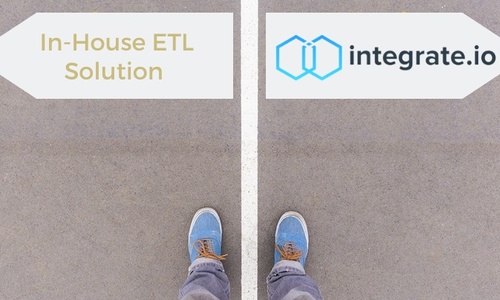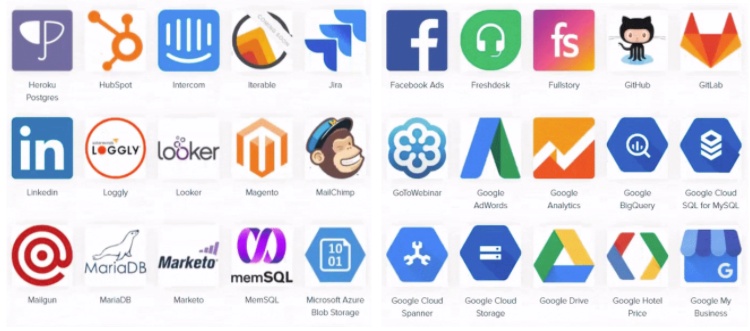5 Quick Differences Between In-House ETL and Integrate.io:
- In-house ETL requires programming skills. Integrate.io is simple for anyone to use.
- In-house ETL is inexpensive up-front but costly long-term. Integrate.io is affordable near and long-term.
- In-house ETL has no user support. All Integrate.io accounts have unlimited user support.
- In-house ETL takes weeks to code. Integrate.io lets you build sophisticated ETL in minutes.
- In-house ETL is prone to human error. Integrate.io replicates proven data integrations.
Should your IT department spend weeks hand-coding an in-house ETL process from scratch? Or should you implement an automatic ETL solution like Integrate.io to build the same data pipeline in minutes? The decision could be difficult because each path offers distinct advantages and disadvantages:
- In-house ETL: A traditional approach for hand-coding ETL pipelines in-house. These do-it-yourself, custom integrations can be costly, time-consuming, and prone to error. But for some projects, in-house ETL offers greater flexibility, control, and up-front cost-savings.
- Integrate.io: A cloud-based ETL platform that empowers ETL-beginners without coding skills to rapidly develop complex, powerful, and cost-effective data pipelines. Integrate.io also allows experienced data engineers to code more nuanced transformations using SQL or Integrate.io’s native scripting language.
In this guide, we’ll examine the differences between in-house ETL and Integrate.io, so you can decide which data integration strategy is best for your needs. We’ll start with a brief overview of the goals and functions of ETL. Then we’ll take an in-depth look at in-house ETL and Integrate.io to see how they’re different.
Please use these links to navigate this guide:
- Side-by-Side Comparison of In-House ETL vs. Integrate.io
- ETL Goals and Functions
- In-House ETL Review
- Integrate.io Review
- Questions to Decide if In-House ETL or Integrate.io Is Best
- Final Thoughts on In-House ETL vs. Integrate.io
Side-by-Side Comparison of In-House ETL vs. Integrate.io
Comparison |
In-House ETL |
Integrate.io |
|
Use-cases served |
ETL, ELT, Data Integration |
ETL, ELT, Reverse ETL, REST API, CDC, and Data Integration |
|
Skill level required |
Requires skilled data engineers with extensive coding experience |
No coding skills required; easy for beginners |
|
Auxiliary costs |
Any or all: Hardware costs, cloud hosting fees, server licensing costs, hosting fees, skilled labor costs, long-term maintenance and troubleshooting costs, variable monthly costs based on data volume and processing |
Zero auxiliary costs |
|
Native connectors |
N/A |
140 pre-built connectors for popular databases, data sources, apps, and SaaS services, including a REST API connector |
|
User support availability |
N/A |
Unlimited email, voice, and video support for all users
|
|
Developer tools |
N/A |
SQL Editor, Native Scripting Language, REST API, and unlimited user support |
|
Database replication features |
Possible with the right skills |
Full dump and load replication, incremental replication based on an update indicator column (such as updated_at) |
|
Support for service level agreements (SLAs) available? |
Possible with the right skills |
Yes |
|
Data compliance, security, and encryption |
Possible with the right skills |
SSL/TLS encryption; GDPR, CCPA, HIPAA & SOC 2 certified. |
ETL Goals and Functions
The ETL journey begins with the realization that you need a more effective way to analyze and understand your data. Achieving this requires three primary components: a data warehouse; a business intelligence (BI) platform; and an ETL strategy. Your ETL strategy extracts, transforms, and loads data from different sources into the data warehouse, so the BI tools can access it.
The ETL component includes the following three steps:
- Extract: Pull information data from a specific source or database.
- Transform: Convert the data into a single format so the destination (data warehouse) can read it.
- Load: Push the data into the data warehouse. Data warehouses are optimized for high-speed read operations. This allows BI tools to efficiently analyze the information they contain.
After developing the ETL process, data integration becomes an automated job that happens on a predetermined schedule.
Related Read: “What is ETL?”
Key takeaways: ETL’s primary function is to aid business intelligence (BI) tools by moving fresh data into a data warehouse for analysis. Without ETL-ing data to a data warehouse, most large organizations would lack the actionable intelligence they require for strategic decision-making.
In-House ETL Overview
From the 1980s to the 2000s, hand-coded ETL took weeks to develop, but it was the only method available. While most businesses had to outsource ETL development, large enterprises were able to maintain in-house developers to code “do-it-yourself” data integrations themselves. Most enterprises continue to have IT teams available for in-house ETL development.
Data engineers who hand-code ETL operations may need programming skills in one or more of the following languages:
- SQL
- Java
- Python
- Apache Pig
- Bash
- Perl
Although it takes time and programming skills, hand-coding in-house ETL has some advantages:
- Flexibility to develop data integrations to fit unique scenarios with endless possibilities.
- Total control over the ETL process without the parameter settings that often apply to ETL tools.
- Upfront cost savings for simple ETL development compared to using large ETL platforms like MuleSoft, Talend, Jitterbit, etc.
- Some experienced data engineers prefer coding to a graphical user interface.
Nevertheless, the disadvantages of in-house ETL often outweigh the rewards:
- Time delays: It can take weeks to hand-code bespoke ETL processes.
- Skilled labor requirement: In-house ETL requires skilled labor to develop, test, manage, and maintain in-house ETL.
- Error-prone: The risk of human error is greater as a result of hand-coding.
- Expensive: There is a high financial cost of ownership over time, due to hardware/software/hosting/labor requirements.
- No customer support: If you run into problems, your IT department will need to create a solution on its own.
- No prebuilt integrations/transformations: There are no prebuilt integrations or transformations. Everything is coded from scratch.
- Less agile: Any changes will take time, requiring detailed attention from a data engineer with coding skills.
Despite the time delays, inefficiencies, high costs, and monotony of hand-coded ETL, many organizations still cling to this old way of doing things – even though the latest automatic ETL technology is dramatically faster, easier-to-use, and less expensive.
Automatic ETL-as-a-Service platforms – like Integrate.io – offer an efficient and affordable alternative to in-house ETL. These platforms eliminate the costs and tedium of traditional, hand-coded integrations. In the case of Integrate.io, the platform is so easy to use that anyone can bypass weeks of hand-coding monotony to quickly develop sophisticated, enterprise-grade ETL. Early adopters of this technology are gaining tremendous competitive advantages in their industries.
Here’s how one developer describes in-house ETL versus modern ETL-as-a-Service:
“I think it's a good idea to use an ETL product rather than build custom software when: Your development team has little experience with this domain – doesn't know where to start, doesn't know the vocabulary or common problems & solutions; you already have a huge investment in a tool – and a lot of people skilled in it that prefer using it; you plan to build & manage an enormous number of feeds and staff the work with folks that think of themselves as a little more business analyst than programmer.” -Kenfar
Key takeaways: Custom, in-house ETL pipelines offer greater flexibility and control over your data. However, the real cost of ownership is high due to hardware, hosting, management, and labor. Hand-coded integrations are also prone to human error. Conversely, ETL-as-a-Service products like Integrate.io present a more cost and time-efficient solution for most modern ETL use-cases.
Integrate.io Overview
Since the early 2010s, automatic ETL platforms have eliminated the need for hand-coded ETL integrations. These “ETL-as-a-Service” products offer prebuilt data connections and readymade data transformations, so you can quickly establish pipelines between the most popular sources/destinations.
However, most enterprise-level ETL products – like MuleSoft and Talend – require extensive training and experience to operate. They are also expensive. On the other hand, more affordable solutions – like Stitch – tend to be limited in power and capabilities.
Integrate.io is different because it merges the power of an enterprise-grade solution with affordability and ease-of-use. In fact, Integrate.io is so easy to operate that anyone can use it to build sophisticated ETL workflows. Plus, Integrate.io accounts receive unlimited customer support, so novice users can work with a dedicated specialist to set up the integrations they need.
Here’s what users say about Integrate.io customer support:
“[Integrate.io] customer support is one of the best I have experienced. They were very prompt every time I would have an issue with using Integrate.io. Moreover, the development team is also quite fast, as they were able to implement pagination for an API I was using in less than 2 days.” -Alexandru B.
“As a bonus to the product features, Integrate.io has excellent customer service. The team goes above and beyond to work with us to develop our data flows and answer any questions we have about the product in their real-time chat system. If bugs or feature requests are discussed, the support team works with us to find adequate workarounds and keeps us in-the-loop while the fix/feature is implemented.” -Lally B.
When it comes to ETL, Integrate.io is not lacking in power and capabilities. Here are some of the platform’s best features:
- Cloud-native: A cloud-born platform that users access from anywhere.
- Graphical user interface: A drag-and-drop interface for developing data integrations and in-pipeline data transformations.
- Prebuilt connectors: Integrate.io features 140 native connectors for widely-used data warehouses, databases, apps, and cloud-based SaaS solutions.
- Salesforce-to-Salesforce: Powerful prebuilt Salesforce integrations that ETL from one Salesforce org to another, plus the ability to extract data from Salesforce, transform/enrich the data, and push it back into Salesforce.
- REST API connector: A REST API connector to quickly establish custom integrations with uncommon sources/destinations. Between Integrate.io’s pre-built connectors and REST API connector, integrations between virtually any source/destination are possible.
- Out-of-the-box transformations: Readymade data transformations that ETL beginners can customize using a no-code, graphical UI.
- Custom-coding options available: Advanced users can customize ETL workflows in SQL or in Integrate.io’s native scripting language.
- Security/Compliance/Encryption: SOC 2, GDPR, CCPA, and HIPAA compliant; SSL/TLS encryption; and physically hosted and managed with Amazon data centers, which feature AWS security technology.
- Email alerts: No special setup required to receive email alerts.
- Virtually unlimited scaling: Integrate.io uses dynamically-created clusters to offer virtually unlimited scaling.
- Pricing: Integrate.io pricing is tailored exactly to each client's needs and requirements with a usage-based component coupled with features and functionality. Clients choose which level of platform usage they will require and then which features and functionality to create a custom plan to fit their use case.
- No auxiliary costs: No physical or cloud-hosted servers are required to run Integrate.io because it is based fully in the cloud. Integrate.io does not require skilled staff to operate, so there will not be any additional labor costs.
Here’s a sample of Integrate.io’s native integrations:
Here are two more reviews from Integrate.io users:
“There are mostly two types of ETL as a service on the market: one is super easy to use and can migrate your data across services and databases but lacks transformation capabilities, while the other needs full-time data engineers to operate but tailored solutions are available programmatically. Integrate.io sits in the golden middle letting analysts and engineers deploying custom transformation jobs in minutes even based on multiple data sources.” -Tamas S.
“Integrate.io is on PAR with enterprise-level tools.” -Guru Kiran S.
Key takeaways: Integrate.io brings ETL down-to-earth, empowering all team members to design specialized data integrations and transformation workflows. The platform eliminates all auxiliary costs because it is cloud-native, runs fully in the cloud, uses a flat-rate pricing model, and manages transformations in-pipeline. At the end of the day, Integrate.io offers a host of powerful, enterprise-grade ETL capabilities that are usually only found in the most expensive and difficult-to-use integration solutions.
Ask These Questions to Decide if In-House ETL or Integrate.io Is Right for Your Needs
Answering the following questions with stakeholders, key developers, and decision-makers will help you evaluate whether in-house ETL or Integrate.io is right for your needs:
1) What are the costs?
The upfront cost of hand-coded ETL may offer savings if you have an in-house data engineering team. However, once you factor in maintenance, troubleshooting, and skilled labor over time, the costs are higher than the average ETL-as-a-Service product. According to a Gartner survey, businesses report saving 20% with in-house ETL upfront, but the long-term price of maintenance is 200% higher.
Because Integrate.io eliminates auxiliary costs associated with skilled labor, hardware, hosting, data volume, and processing – it can lower your ETL cost burden by an order of magnitude. Moreover, Integrate.io’s flat-rate, per-connector pricing offers predictable and easy-to-budget billing.
2) Do you have the time?
It can take weeks to develop a bespoke ETL pipeline in-house – and this is only after your IT department is readily available. Do you want to wait that long? With Integrate.io, ETL novices can use Integrate.io’s drag and drop interface to select from over 140 pre-built connectors – then they can design complex transformation workflows without involving your IT department. Best of all, they can create these data integrations in less than a day – often in just minutes.
Integrate.io allows you to build an ETL pipeline with a few clicks of your mouse:
3) Does your team have the requisite coding and data engineering expertise?
Does your data engineering team have the advanced coding skills, experience with Hadoop, and knowledge of cloud data integrations required to develop hand-coded ETL operations? Hiring these team members will be too expensive for most small to medium-sized firms. According to ZipRecruiter, the average salary for ETL developers is approximately $110,000.
Considering that anyone can use Integrate.io – from the CEO’s executive assistant to an accountant in finance – you eliminate the high cost of skilled labor, making Integrate.io dramatically less expensive than custom-coded ETL.
4) How many developers are working on the project?
It can be difficult for multiple team members to maintain a bird’s-eye understanding of in-house ETL code. This challenge worsens when the original ETL developers depart. There will be significant learning curves (and financial costs) related to training new staff down the road.
Here’s what it’s like to visualize an ETL pipeline with Integrate.io’s graphical user interface:
The more developers on the project, the more you’ll want Integrate.io’s standardized, graphical view of the data pipeline. This allows everyone to quickly grasp the scope of the project. Moreover, new developers on the project will have an easier time picking up where their predecessors left off.
5) Can Integrate.io address your use-case?
Integrate.io offers a high degree of customization because of its native scripting language and support for SQL-coded transformations. However, there are some use-cases that no ETL-as-a-Service tool can address. In these situations, you may need to code a bespoke solution to manage nuanced transformations or specialized algorithms.
6) Will it scale and how often will you need to make changes?
Integrate.io scales to your increasing business requirements by spinning up new clusters dynamically. Plus, the platform does not charge based on data volume or processing, so costs stay the same when data volumes spike. Integrate.io also allows you to add/remove ETL connections quickly in response to changing business requirements.
Edit and scale an Integrate.io cluster in just a few seconds:
In contrast, scaling an in-house solution can be difficult if your framework doesn’t support adding new nodes. Moreover, if you’re running the process on a physical machine, you will inevitably hit scaling trouble as your data grows. Finally, it’s important to remember that updates to bespoke ETL pipelines require hand-coded alterations which take time – even when your IT department is available to address the issue.
7) Can Integrate.io do it faster, easier, and more affordably?
Why burden your IT team with additional work when Integrate.io can usually achieve the same results faster, more affordably, and with a reduced chance of human error? Integrate.io has the versatility required to manage most ETL use-cases. Moreover, it is adept at handling data integrations for cloud-based SaaS platforms.
In contrast to hand-coded, in-house ETL, let’s review the advantages of Integrate.io:
- Easier to use without IT or coding knowledge
- Easier to manage, maintain, and change over the long-term
- Less expensive to set up and maintain integrations
- Faster to set up data integrations
- No auxiliary costs
- Easier and faster to scale
- Less prone to human error
- Advanced data security, compliance, and encryption baked into the platform
- A wide variety of connectors, including REST API and Salesforce to Salesforce
- Awesome and attentive customer support team
Final Thoughts on In-House ETL vs. Integrate.io
Let’s end this piece with a brief analogy. Imagine you have a busy career, a lot of responsibilities, and you need a new sweater. If you have the skills, you can knit a custom sweater to your exact specifications, but it’s going to take a month! Alternatively, you can buy a pre-made designer sweater now – and it will be just as warm, cozy, and stylish.
Which will you choose?
Choosing Integrate.io (the pre-made designer sweater) makes sense. It allows you to get what you need right now – without acquiring additional skills – and it frees you up to focus on more important responsibilities.
Want to try Integrate.io for yourself? Contact our team and schedule a demo today.

















